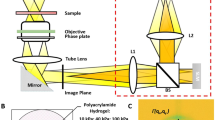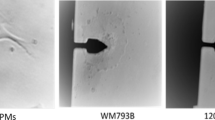Abstract
Purpose
To understand how nanomechanical stiffness affects metastatic potential, we studied the relationship between cell migration, a characteristic of metastasis, and cell stiffness using atomic force microscopy (AFM), which can measure stiffness (elasticity) of individual living cells.
Methods
Migration and cell stiffness of three metastatic B16 melanoma variants (B16-F10, B16-BL6, and B16-F1 cells), and also effects of (−)-epigallocatechin gallate (EGCG), were studied using Transwell assay and AFM.
Results
Migration of B16-F10 and B16-BL6 cells was 3 and 2 times higher than that of B16-F1 cells in Transwell assay, and cell stiffness determined by AFM was also different among the three variants, although they have similar morphologies and the same growth rates: Means of Young’s modulus were 350.8 ± 4.8 Pa for B16-F10 cells, 661.9 ± 16.5 Pa for B16-BL6 cells, and 727.2 ± 13.0 Pa for B16-F1 cells. AFM measurements revealed that highly motile B16-F10 cells have low cell stiffness, and low motile and metastatic B16-F1 cells have high cell stiffness: Nanomechanical stiffness is inversely correlated with migration potential. Treatment of highly motile B16-F10 cells with EGCG increased cell stiffness 2-fold and inhibited migration of the cells.
Conclusions
Our study with AFM clearly demonstrates that cell stiffness is a reliable quantitative indicator of migration potential, and very likely metastatic potential, even in morphologically similar cells. And increased cell stiffness may be a key nanomechanical feature in inhibition of metastasis.





Similar content being viewed by others
Abbreviations
- AFM:
-
Atomic force microscopy
- EGCG:
-
(−)-Epigallocatechin gallate
- MβCD:
-
Methyl-β-cyclodextrin
References
Adachi S, Nagao T, Ingolfsson HI, Maxfield FR, Andersen OS, Kopelovich L, Weinstein IB (2007) The inhibitory effect of (−)-epigallocatechin gallate on activation of the epidermal growth factor receptor is associated with altered lipid order in HT29 colon cancer cells. Cancer Res 67:6493–6501
Anand P, Sundaram C, Jhurani S, Kunnumakkara AB, Aggarwal BB (2008) Curcumin and cancer: an “old-age” disease with an “age-old” solution. Cancer Lett 267:133–164. doi:10.1016/j.canlet.2008.03.025
Bao G, Suresh S (2003) Cell and molecular mechanics of biological materials. Nat Mater 2:715–725
Bettuzzi S, Brausi M, Rizzi F, Castagnetti G, Peracchia G, Corti A (2006) Chemoprevention of human prostate cancer by oral administration of green tea catechins in volunteers with high-grade prostate intraepithelial neoplasia: a preliminary report from a one-year proof-of-principle study. Cancer Res 66:1234–1240
Binnig G, Quate CF, Gerber C (1986) Atomic force microscope. Phys Rev Lett 56:930–933
Connors SK, Chornokur G, Kumar NB (2011) New insights into the mechanisms of green tea catechins in the chemoprevention of prostate cancer. Nutr Cancer. doi:10.1080/01635581.2012.630158
Costa KD (2003) Single-cell elastography: probing for disease with the atomic force microscope. Dis Markers 19:139–154
Cross SE, Jin Y-S, Rao JY, Gimzewski JK (2007) Nanomechanical analysis of cells from cancer patients. Nat Nanotechnol 2:780–783
Cross SE, Jin Y-S, Rao JY, Gimzewski JK (2009) Applicability of AFM in cancer detection. Nat Nanotechnol 4:72–73
Cross SE, Jin Y-S, Lu Q-Y, Rao JY, Gimzewski JK (2011) Green tea extract selectively targets nanomechanics of live metastatic cancer cells. Nanotechnology 22:215101–215110
Duncan LM, Deeds J, Hunter J, Shao J, Holmgren LM, Woolf EA, Tepper RI, Shyjan AW (1998) Down-regulation of the novel gene melastatin correlates with potential for melanoma metastasis. Cancer Res 58:1515–1520
Fidler IJ (1973) Selection of successive tumour lines for metastasis. Nat New Biol 242:148–149
Fritsch A, Hockel M, Kiessling T, Nnetu D, Wetzel F, Zink M, Kas JA (2010) Are biomechanica changes necessary for tumour progression? Nat Phys 6:730–732
Fujiki H (2005) Green tea: health benefits as cancer preventive for humans. Chem Rec 5:119–132
Fujiki H, Okuda T (1992) (−)-Epigallocatechin gallate. Drugs Future 17:462–464
Guo Q, Xia Y, Sandig M, Yang J (2012) Characterization of cell elasticity correlated with cell morphology by atomic force microscope. J Biomech 45:304–309
Lekka M, Laidler P, Gil D, Lekki J, Stachura Z, Hrynkiewicz AZ (1999) Elasticity of normal and cancerous human bladder cells studied by scanning force microscopy. EBJ 28:312–316
Levy R, Maaloum M (2002) Measuring the spring constant of atomic force microscope cantilevers: Thermal fluctuations and other methods. Nanotechnology 13:33–37
Li QS, Lee GY, Ong CN, Lim CT (2008) AFM indentation study of breast cancer cells. Biochem Biophys Res Commun 374:609–613. doi:10.1016/j.bbrc.2008.07.078
Liotta LA, Mandler R, Murano G, Katz DA, Gordon RK, Chiang PK, Schiffmann E (1986) Tumor cell autocrine motility factor. Proc Natl Acad Sci USA 83:3302–3306
Menon LG, Kuttan R, Kuttan G (1999) Anti-metastatic activity of curcumin and catechin. Cancer Lett 141:159–165
Poste G, Doll J, Hart IR, Fidler IJ (1980) In vitro selection of murine B16 melanoma variants with enhanced tissue-invasive properties. Cancer Res 40:1636–1644
Remmerbach TW, Wottawah F, Dietrich J, Lincoln B, Wittekind C, Guck J (2009) Oral cancer diagnosis by mechanical phenotyping. Cancer Res 69:1728–1732
Schroeder F, Gardiner JM (1984) Membrane lipids and enzymes of cultured high- and low-metastatic B16 melanoma variants. Cancer Res 44:3262–3269
Shimizu M, Fukutomi Y, Ninomiya M, Nagura K, Kato T, Araki H, Suganuma M, Fujiki H, Moriwaki H (2008) Green tea extracts for the prevention of metachronous colorectal adenomas: a pilot study. Cancer Epidemiol Biomarkers Prev 17:3020–3025
Singh BN, Shankar S, Srivastava RK (2011) Green tea catechin, epigallocatechin-3-gallate (EGCG): mechanisms, perspectives and clinical applications. Biochem Pharmacol 82:1807–1821. doi:10.1016/j.bcp.2011.07.093
Steeg PS (2006) Tumor metastasis: mechanistic insights and clinical challenges. Nat Med 12:895–904. doi:10.1038/nm1469
Suresh S (2007) Nanomedicine: elastic clues in cancer detection. Nat Nanotechnol 2:748–749
Swaminathan V, Mythreye K, O’Brien ET, Berchuck A, Blobe GC, Superfine R (2011) Mechanical stiffness grades metastatic potential in patient tumor cells and in cancer cell lines. Cancer Res 71:5075–5080
Taniguchi S, Fujiki H, Kobayashi H, Go H, Miyado K, Sadano H, Shimokawa R (1992) Effect of (−)-epigallocatechin gallate, the main constituent of green tea, on lung metastasis with mouse B16 melanoma cell lines. Cancer Lett 65:51–54
Trickey WR, Baaijens FP, Laursen TA, Alexopoulos LG, Guilak F (2006) Determination of the Poisson’s ratio of the cell: recovery properties of chondrocytes after release from complete micropipette aspiration. J Biomech 39:78–87
Tsao AS, Liu D, Martin J, Tang XM, Lee JJ, El-Naggar AK, Wistuba I, Culotta KS, Mao L, Gillenwater A, Sagesaka YM, Hong WK, Papadimitrakopoulou V (2009) Phase II randomized, placebo-controlled trial of green tea extract in patients with high-risk oral premalignant lesions. Cancer Prev Res (Phila) 2:931–941
Wu Y, McEwen GD, Harihar S, Baker SM, DeWald DB, Zhou A (2010) BRMS1 expression alters the ultrastructural, biomechanical and biochemical properties of MDA-MB-435 human breast carcinoma cells: an AFM and Raman microspectroscopy study. Cancer Lett 293:82–91. doi:10.1016/j.canlet.2009.12.016
Yancey PG, Rodrigueza WV, Kilsdonk EP, Stoudt GW, Johnson WJ, Phillips MC, Rothblat GH (1996) Cellular cholesterol efflux mediated by cyclodextrins. Demonstration of kinetic pools and mechanism of efflux. J Biol Chem 271:16026–16034
Yang CS, Wang X (2010) Green tea and cancer prevention. Nutr Cancer 62:931–937. doi:10.1080/01635581.2010.509536
Yoshida T, Isaka H, Nakamura K, Odashima S, Satoh H (1955) Studies on the ascites hepatoma. Trans Soc Pathol Jpn 44:407–426
Yoshizawa S, Horiuchi T, Suganuma M, Nishiwaki S, Yatsunami J, Okabe S, Okuda T, Muto Y, Frenkel K, Troll W, Fujiki H (1992) Penta-O-galloyl-β-d-glucose and (−)-epigallocatechin gallate. ACS Symp Ser 507:316–325
Acknowledgments
We thank Drs. James K. Gimzewski and Shivani Sharma, University of California, and Drs. Kunihiko Okajima and Mariko Ago, Tokushima Bunri University, for their fruitful discussion. We also thank Dr. Shun’ichiro Taniguchi for the supply of B16 variants, and Mr. Takahisa Matsuzaki, Ms. Kaori Suzuki and Ikuko Shiotani, Research Institute for Clinical Oncology, Saitama Cancer Center, for their technical assistance. This work was supported by the Smoking Research Fundation, Urakami Foundation, and World Premier International Research Center Initiative on Materials Nanoarchitectonics (H. K. and T. N.). This work was supported in part by the Nanotechnology Network Japan Program from the Ministry of Education, Culture, Sports, Science and Technology of Japan.
Conflict of interest
The authors did not have any conflicts of interest to disclose.
Author information
Authors and Affiliations
Corresponding author
Additional information
T. Watanabe and H. Kuramochi contributed equally to this work.
Rights and permissions
About this article
Cite this article
Watanabe, T., Kuramochi, H., Takahashi, A. et al. Higher cell stiffness indicating lower metastatic potential in B16 melanoma cell variants and in (−)-epigallocatechin gallate-treated cells. J Cancer Res Clin Oncol 138, 859–866 (2012). https://doi.org/10.1007/s00432-012-1159-5
Received:
Accepted:
Published:
Issue Date:
DOI: https://doi.org/10.1007/s00432-012-1159-5




